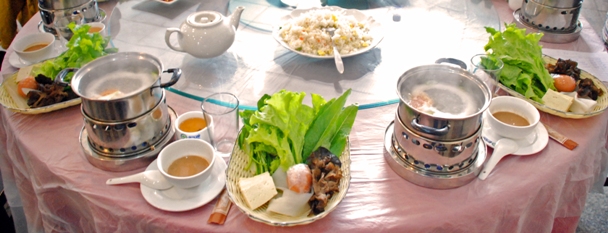I love to eat hot soups and stews to chase away the chill of a cold day. Asian soups are wonderful for this purpose. From Korean Doenjang Jjiggae to Central Asian Shurpa, Asian soups are hearty, delicious and offer unusual flavor combinations for warding off winter weather. The Chinese have a dish that is an intermediary between a soup and a stew for warding off the cold called a firepot. I got to enjoy a northern firepot recently in the countryside northwest of Beijing, on the way to Badaling, and can attest that it is a tasty way to keep warm.
Briefly a firepot is a metal pot of one shape or another with broth in it, into which you cook meat, vegetables, tofu, noodles and sometimes an egg. Sometimes pots are communal, other times they are individual or shared between two or three diners. Traditionally, they were heated with charcoal, but today the most common form of heating is from propane, which provides a steady, constant heat. You can enjoy the ingredients one or two at a time with rice and a couple of sauces or wait until the ingredients have melded into a rich dish. Firepots can be flavorful and spicy as they often are in the South and West or mild and salty as they often are in the North and East.
The dish is of Northern origin, arising in Northern China, Mongolia and Manchuria and spreading to the rest of the country from there. Formal histories site the spread across northern China by the time of the Tang Dynasty (618-906 ACE), and then on to the rest of the Empire. Beyond China, the dish has been adopted and adapted from Japan and Korea to Vietnam and Thailand.
The day we ventured out of the city toward Badaling was a typical late autumn day – very cold and dry. After leaving the city, the smog began to clear and the highway sliced through uplifted mountains dotted with pines and evergreens that looked like a geological textbook with the layers of history laid bare. Soon enough the blanket of pines thinned as the vegetation became scrubbier and the soil more beige. The shaggy auburn coats of working Bactrian camels dotted the dirt road that flowed beside the modern highway and the colorful clothes of citydwellers gave way to the simple rural uniform of black pants and indigo jackets that were easily spotted against the pale landscape.
The area just south of Badaling is one of China’s areas renowned for goose farming. As some of you may already know, China leads the world in the number of geese and ducks it brings to market each year. It produces more than two-thirds of the world’s birds. What the area around Badaling specializes in is goose-liver production – the bulk of which is destined for markets and restaurants in France and western Europe.
Subsequently, goose meat is inexpensive and commonly consumed in the area. This is where we enjoyed our Goose Firepot. The windows of the simple rural restaurant were steamed up because of the amount of boiling broth at the tables inside.
The broth in our individual firepots was a salty chicken broth which I quickly threw some crushed ginger and garlic into to boost the flavor. The greens offered were a mix of mustard and radish greens, lettuce and spinach. Also on our plates were tree-ear mushrooms, tofu, radish noodles and an egg. The goosemeat was thinly sliced like low-sodium bacon and had a dusky, rich flavor that I love. The dipping sauce was made of crushed sesame seeds mixed with sesame oil, water, a chili or two and a bit of soy – sort of like a watery tahini. I enjoyed everything except the thick radish noodle. My dislike was largely because of the size and slimy consistency of the noodle. If they were thinly sliced, I don’t think that it would have been a problem.
I tried the firepot both ways – one by one with rice and sesame sauce, and as a bit more of a soup. Of the two, I preferred the former, mostly because the salty chicken broth left a bit to be desired, and I had nothing on hand to flavor it with. I chose to boil the egg whole and eat it sliced as part of the meal, but others swirled it into the soup to create texture. It was a wonderful lunch and warmed me for the steep hike up the Badaling wall to view that followed.
We were told by our guide that there were two ways up the wall – the hard way and the harder way. We chose the harder way, because it was much less crowded and seemed more peaceful. Our kids ran all the way up and on to the barbed-wired end while we took in the sights with slower stride. The wall is very steep in places and one needs to grab on to the edge for balance going up and coming down. My husband and I paused on the watchtowers to take in the surrounding landscape and gorgeous desolation and listen to the echo of the hooves of the Mongol horses rallying at the gate. Our only company was a talkative magpie and a few travelers continuing on. (Words and photos by Laura Kelley).

